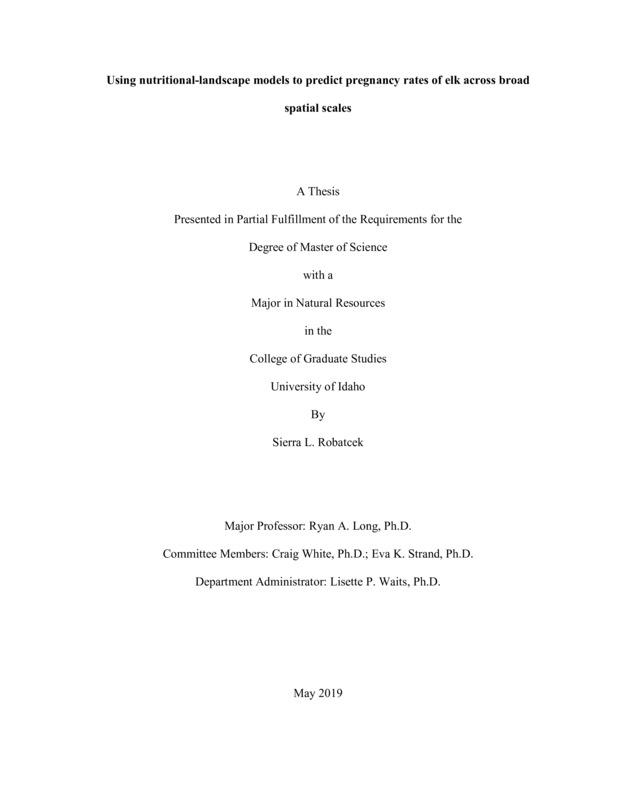Using nutritional-landscape models to predict pregnancy rates of elk across broad spatial scales
Robatcek, Sierra LeeAnn. (2019-05). Using nutritional-landscape models to predict pregnancy rates of elk across broad spatial scales. Theses and Dissertations Collection, University of Idaho Library Digital Collections. https://www.lib.uidaho.edu/digital/etd/items/robatcek_idaho_0089n_11550.html
- Title:
- Using nutritional-landscape models to predict pregnancy rates of elk across broad spatial scales
- Author:
- Robatcek, Sierra LeeAnn
- Date:
- 2019-05
- Program:
- Natural Resources
- Subject Category:
- Wildlife management
- Abstract:
-
Understanding how the choices made by individal herbivores as they navigate heterogeneous landscapes scale up to influence population performance is critical for accurately forecasting population trajectories. In recent decades, elk (Cervus canadensis) populations in Idaho have exhibited considerable variation in multiple vital rates, including pregnancy. Because elk populations that are not resource limited typically display high pregnancy rates (>80%), and several populations in Idaho regularly fall below this threshold, there is concern that habitat quality may be limiting the productivity of those populations. Nutritional condition is a primary driver of reproductive success in female herbivores, and thus poor habitat quality, suboptimal use of the nutritional landscape by elk, or a combination of both could cause depressed pregnancy rates. The goal of our research was to develop a series of linked dynamic models for predicting a) spatiotemporal variation in the nutritional landscapes available to elk in seven distinct populations in Idaho and b) interannual variation in pregnancy rates of those populations as a function of the overall quality and abundance of forage resources available to them and/or how they used those resources. Regression models for explaining spatiotemporal variation in usable forage biomass (biomass of forage that met or exceeded requirements for a female elk at peak lactation) generally performed well in each of our three study areas, with adjusted R2 values ranging from 0.26 to 0.61. High-quality foraging habitat was most abundant during summer in the Teton and Diamond Creek elk zones, and was least abundant in the Beaverhead and Sawtooth elk zones. This trend was similar during the fall, with the Teton and South Fork of the Clearwater elk zones supporting the most high-quality habitat, and the Beaverhead and Sawtooth zones supporting the least high-quality habitat. Differing patterns of habitat use were observed among the four elk populations for which we had simultaneous GPS-collar and pregnancy data. Elk in the Diamond Creek and Sawtooth zones appeared to utilize the nutritional landscape sub-optimally (i.e., locations used by elk had less high-quality forage than random locations on the landscape), particularly during summer (June 1 – July 31), whereas elk in the South Fork of the Clearwater used high-quality foraging habitat in greater proportion than it was available. Our top model for relating pregnancy rates of elk to the nutritional landscape explained 60% of the variation in pregnancy rates among 18 elk-population-years. Our top model for relating pregnancy of elk to how they used the nutritional landscape explained 75% of the variation in pregnancy rates among 10 population-years. Variation in pregnancy rates was positively related to both the maximum value of usable forage biomass and the degree of heterogeneity in the nutritional landscape across elk management zones in Idaho. This supports our hypothesis that pregnancy is mediated by habitat quality, and provides additional empirical evidence of a fundamental link between the nutritional landscape in summer and fall and population performance of elk.
- Description:
- masters, M.S., Natural Resources -- University of Idaho - College of Graduate Studies, 2019-05
- Major Professor:
- Long, Ryan A
- Committee:
- White, Craig G; Strand, Eva K
- Defense Date:
- 2019-05
- Identifier:
- Robatcek_idaho_0089N_11550
- Type:
- Text
- Format Original:
- Format:
- application/pdf
- Rights:
- In Copyright - Educational Use Permitted. For more information, please contact University of Idaho Library Special Collections and Archives Department at libspec@uidaho.edu.
- Standardized Rights:
- http://rightsstatements.org/vocab/InC-EDU/1.0/

